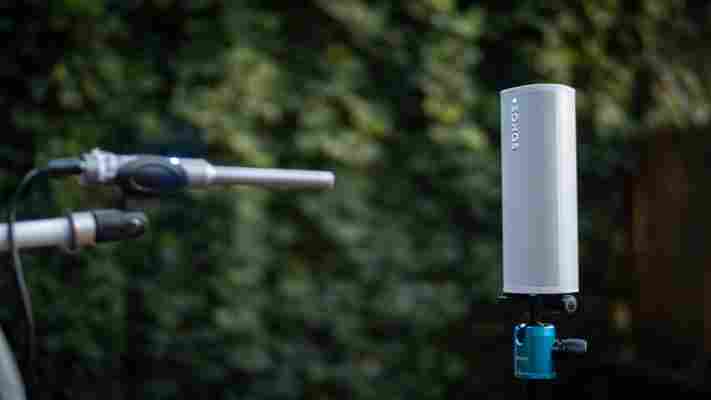Smart speakers and portable speakers get a bad rap in the audiophile world, and the Sonos Roam is both smart and portable. But as we showed with Google’s Nest Audio , there’s no reason wireless speakers can’t bring serious sound quality. The Sonos Roam, like the Sonos Move before it, is a pretty rad little Bluetooth speaker –and we’ve got the data to show why.

First things first, my colleague Callum Booth already wrote an excellent review of the Roam and made an awesome video about it. You should watch that:
But sometimes we like to do get different perspectives here at TNW. I’m a bit of an audio nerd, and I like to look at the data behind a speaker to get a more objective understanding of its performance. While my own listening impressions largely line up with Callum’s, the data gives us something more concrete evidence to back that up.
So let’s get straight to it: the Sonos Move shows excellent technical performance, better than a portable Bluetooth speaker has any right to show. Its main limitation is that it won’t get crazy loud, but the sound that is there has remarkable tonal balance.
For these tests, I tested the Roam via Bluetooth and turned off Auto-TruePlay all the extra features like EQ and loudness compensation. The following represents the speaker playing back music in its purest form. I do think TruePlay does a pretty bang-up job most of the time, but it’s hard to measure a speaker when its response is constantly changing.
I conducted most of my tests at 80% volume, which I measured at about 76dB at 1 meter. That’s about as loud as an old-school vacuum cleaner if you want some, umm, perspective.
And here is the speaker at 60% volume, or about 68 dB at 1 meter, which is about as loud as a shower.
Okay, I realize the above probably just looks like a bunch of squiggly lines to you. Don’t worry! I wrote a whole guide on how to interpret these charts, and why they’re so useful to know. But if you don’t have the time to read 4,000 words of me nerding out, we can focus on just a few of these measurements.
The above graph is called a ‘spinorama.’ Technically, it’s a CTA-2034A graph, which is the standard for showing describing what a speaker sounds like in one graph. Creating one means I had to set up a rig to capture the speaker’s response at 70 different angles (it sounds cooler than it is; I just put the speaker on a tripod). The speaker was measured in its vertical orientation, standing on its end. The type of measurements I make eliminate the influence of reflections, to get to the ‘true’ sound of a speaker.
The white curve above is the listening window. We generally want this to be a flat line. It represents the direct sound that radiates from the speaker over a window that’s 60 degrees wide horizontally and 20 degrees wide vertically. Basically, it’s what you’ll hear when you’re positioned somewhere roughly in front of the speaker.
This is what’s going to matter the most when you’re listening to the speaker outdoors. We want this to be roughly a flat line, especially from roughly 200 Hz to 10kHz. The Sonos Roam gives us just that for the most part.
In fact, up to about 5kHz, the Roam is actually one of the flattest speakers I’ve measured! Better than some multi-thousand-dollar speakers. Granted, it’s easier to do on a small speaker, but most speakers at this price don’t even bother to approximate a flat response. Sonos clearly did.
There is some excess treble energy above 6kHz that later dips above 15kHz. And you can clearly see the speaker puts out way less bass at 80% volume than at 60%; this is because the built-in DSP is limiting bass output to protect the drivers.
But hey, you can’t win them all. This is a tiny speaker, and there’s only so much you can do about the bass. As Callum noted, Sonos could have squeezed a little more bass by making the speaker just a little bit bigger, and I kind of wish they had.
Here’s how the bass changes at 10% volume increments, going from 100% volume to 50%. I measure this by getting the microphone as close to the woofer as possible.
You can see how after 60 percent, Sonos starts limiting the bass. So if your concern is maximum sound quality, you don’t want to go much louder than that.
Next, we’re going to look at the purple line in the spinoramas. This is the predicted in-room response, which uses the data from all angles to guesstimate what the speaker will sound like indoors. That’s because we don’t just hear the direct sound (the listening window); we also hear the sound that reflects off walls, floors, and ceilings, so every angle matters. If the reflected sound is too different from the direct sound, the speaker sounds sucky.
This graph should also have a flattish shape, but should tilt down by a few dB for a natural sound. We see the Roam also does this well. With just these two curves, we know the Roam is a mostly neutral, tonally balanced speaker free from any terrible anomalies.
The relationship between the direct sound and off-axis sound tells us the speaker’s ‘directivity.’ This basically tells us how good the soundstage is going to be when we’re in a reflective space like a room. It also gives you an idea of how good the speaker will be when you’re not listening directly in front of the speaker.
The graph below shows the speaker’s response changes in 10-degree increments as you move towards the sides of the speakers:
The Roam shows mostly admirable performance. In fact, this graph shows the speaker is actually flattest when you are about 20 or 30 degrees off the center of the speaker. That said, it also shows that the sound changes when you’re somewhere in front of the speake. This is normal, but it’s not like the Sonos Move or some other Bluetooth speakers, which sound almost the same at almost any angle around the speaker.
It’s also worth noting the speaker performs differently in different orientations. The above horizontal directivity was captured with the speaker standing up straight as in the photos in this article the speaker will have a better soundstage if set up this way.
The sound above and below the speaker (again, when it’s standing up straight) isn’t quite as clean. For example, here’s the sound below the speaker in 10-degree increments:
And here’s the sound above:
You don’t need to worry about every individual angle, but you can see it’s a messier affair. All this is to say that if you flip the speaker on its side, you’re going to have a worse soundstage.
Still, it’s very common for speakers to perform better in one direction than the other, even in hifi models. There isn’t much of a soundstage when using a single speaker anyway, and it’s not a big deal if you’re just using the Roam as a party speaker. But if you plan on using a stereo pair of Roams, you’d be much better off keeping the speakers in their vertical orientations.
All this data is to confirm what listening already tells us: the Sonos Roam is a rockin’ little speaker. I can’t promise it’s going to be the best Bluetooth speaker out there, as I don’t normally do this type of analysis for Bluetooth speakers (though I intend to do more of them). Perhaps there are better values out there. And you shouldn’t expect crazy high volumes or the best performance near max volume, as bass will be limited in particular. It’s not going to completely blow your mind if you’re an audiophile; there’s a limit to how much such a little woofer can handle.
But within its comfort zone, the Sonos Roam performs extremely well. It’s a technical show of force that Sonos managed to engineer such a good speaker while making it IP67 water and dust resistant, adding automatic room tuning, and incorporating both Google Assistant and Alexa.
Whether it’s worth $169 is up to you to decide, but if you’re looking for a voice-enabled smart speaker that you can take anywhere with you, the Sonos Roam looks like a fantastic option.

